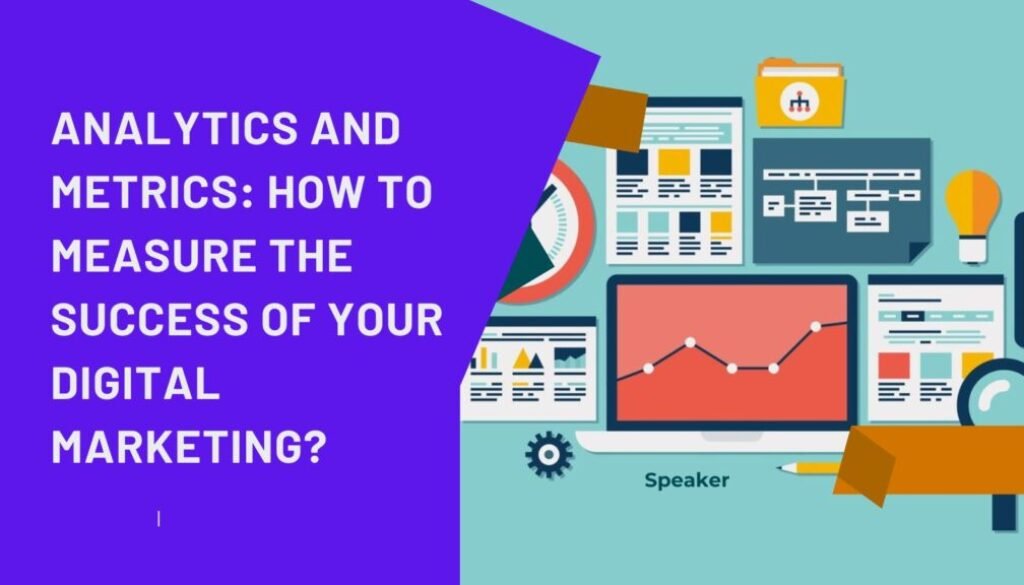Analytics and Metrics: How to Measure the Success of Your Digital Marketing
In today’s digital age, the success of your marketing efforts hinges on your ability to measure and analyse data. Analytics and metrics are essential tools that help businesses understand their audience, track performance, and make data-driven decisions. But with a plethora of metrics available, how do you know which ones are the most important? Let’s dive deep into the world of digital marketing analytics and uncover how you can measure the success of your campaigns effectively.
Understanding Digital Marketing Analytics
Digital marketing analytics is the process of analyzing data to gauge the performance of your marketing activities. It involves collecting, measuring, and interpreting data to understand how your campaigns are performing and what changes can improve their effectiveness.
Tools for Digital Marketing Analytics
Several tools can help you track and analyse your digital marketing efforts. Google Analytics is one of the most popular and powerful tools available. Other tools include HubSpot, SEMrush, and Adobe Analytics. Each tool offers unique features that cater to different aspects of digital marketing.
Key Metrics to Measure Success
To measure the success of your digital marketing efforts, it’s crucial to focus on specific metrics. These metrics can be broadly categorized into traffic, engagement, conversion, and revenue metrics.
Traffic Metrics
Page Views: This metric indicates the total number of pages viewed on your website. It’s a basic but essential metric that shows how much content is being consumed by visitors.
Unique Visitors: Unlike page views, unique visitors represent individual users visiting your site. This metric helps you understand the size of your audience.
Engagement Metrics
Bounce Rate: The bounce rate measures the percentage of visitors who leave your site after viewing only one page. A high bounce rate may indicate that your content isn’t engaging enough.
Average Session Duration: This metric shows how long visitors stay on your site during a single session. Longer sessions typically indicate more engaging content.
Conversion Metrics
Conversion Rate: The conversion rate is the percentage of visitors who complete a desired action, such as making a purchase or filling out a form. This is a crucial metric for measuring the effectiveness of your campaigns.
Cost Per Conversion: This metric calculates the cost incurred to achieve a conversion. It helps you determine the efficiency of your marketing spend.
Revenue Metrics
Return on Investment (ROI): ROI measures the profitability of your marketing efforts. It’s calculated by dividing the net profit by the cost of the investment.
Customer Lifetime Value (CLV): CLV estimates the total revenue a customer will generate over their lifetime. This metric is essential for understanding the long-term value of your customers.
Setting Up Your Analytics
To effectively measure these metrics, you need to set up your analytics correctly.
Choosing the Right Tools
Start by selecting the right tools for your business needs. Google Analytics is a great starting point for most businesses. Additionally, tools like HubSpot and SEMrush can provide more specialized insights.
Setting Up Google Analytics
- Create an Account: Sign up for a Google Analytics account and set up your property.
- Install Tracking Code: Add the tracking code to your website to start collecting data.
- Set Up Goals: Define your goals within Google Analytics to track conversions.
Traffic Analysis
Understanding where your traffic comes from is crucial for optimizing your marketing efforts.
Analysing Traffic Sources
Traffic sources can be divided into several categories: organic, direct, referral, social, and paid. By analyzing these sources, you can determine which channels are driving the most traffic to your site.
Understanding Organic vs. Paid Traffic
Organic traffic comes from search engines, while paid traffic comes from advertising campaigns. Both are essential, but understanding their roles can help you allocate your budget more effectively.
Engagement Analysis
Engagement metrics provide insights into how users interact with your site.
Interpreting Engagement Metrics
By analyzing metrics like bounce rate and average session duration, you can gauge the effectiveness of your content. High engagement typically indicates that your content is resonating with your audience.
Strategies to Improve Engagement
To improve engagement, focus on creating high-quality content that meets the needs of your audience. Additionally, ensure your site is easy to navigate and mobile-friendly.
Conversion Analysis
Conversion metrics are crucial for understanding how well your site converts visitors into customers.
Tracking Conversion Paths
By tracking the paths that visitors take before converting, you can identify potential bottlenecks in your funnel. This insight can help you optimize your conversion process.
Optimizing Conversion Rates
To optimize conversion rates, test different elements of your site, such as headlines, call-to-action buttons, and forms. A/B testing is a powerful method for identifying what works best.
Revenue Analysis
Revenue metrics help you understand the financial impact of your marketing efforts.
Calculating ROI
To calculate ROI, subtract the cost of your marketing efforts from the revenue generated and divide by the cost. This metric provides a clear picture of your campaign’s profitability.
Enhancing Customer Lifetime Value
To enhance CLV, focus on building long-term relationships with your customers. Provide excellent customer service, offer loyalty programs, and continually engage with your audience.
Utilizing Analytics for Strategy Development
Data-driven decision-making is at the heart of successful digital marketing.
Data-Driven Decision Making
By leveraging data, you can make informed decisions that improve your marketing strategies. Use analytics to identify trends, test new ideas, and refine your campaigns.
Adjusting Marketing Strategies Based on Data
Regularly review your analytics to identify areas for improvement. Adjust your strategies based on the data to maximize your marketing efforts.
Advanced Analytics Techniques
For those looking to take their analytics to the next level, advanced techniques can provide deeper insights.
Predictive Analytics
Predictive analytics uses historical data to forecast future trends. This technique can help you anticipate customer behaviour and adjust your strategies accordingly.
Machine Learning in Digital Marketing
Machine learning algorithms can analyze large datasets to identify patterns and insights that would be difficult for humans to detect. This technology can enhance your analytics and provide a competitive edge.
Common Challenges and Solutions
Despite its benefits, digital marketing analytics comes with its own set of challenges.
Dealing with Data Overload
With so much data available, it’s easy to feel overwhelmed. Focus on the most relevant metrics and use tools that simplify data visualization to avoid data overload.
Ensuring Data Accuracy
Accurate data is essential for effective analysis. Regularly audit your analytics setup to ensure your data is accurate and reliable.
Case Study: Successful Digital Marketing Campaigns
Learning from successful campaigns can provide valuable insights.
Examples of Successful Campaigns
Examine case studies of successful digital marketing campaigns to understand what strategies worked and why. Look for campaigns that align with your industry and goals.
Lessons Learned
Analyze the key takeaways from these campaigns and consider how you can apply these lessons to your own marketing efforts.
Learning and Growing Your Skills
Digital marketing is constantly evolving, and staying updated is crucial.
Importance of Continuous Learning
The digital marketing landscape is dynamic, and continuous learning is essential. Enroll in courses and stay updated with the latest trends and techniques.
Digital Marketing Courses in Pune
For those looking to enhance their skills, digital marketing courses in Pune offer comprehensive training. These courses cover everything from basic concepts to advanced strategies, ensuring you’re well-equipped for success.
Choosing the Right Training Institute
Selecting the right training institute can make a significant difference in your learning experience.
What to Look for in a Digital Marketing Training Institute in Pune
When choosing a digital marketing training institute in Pune, consider factors like the curriculum, faculty expertise, hands-on training opportunities, and placement assistance. Institutes that offer comprehensive and up-to-date courses are preferable.
Conclusion
Measuring the success of your digital marketing efforts is crucial for optimizing your campaigns and achieving your business goals. By focusing on key metrics, setting up your analytics correctly, and continuously refining your strategies based on data, you can drive better results and stay ahead of the competition.
FAQs
- What are the essential tools for digital marketing analytics?
- Google Analytics, HubSpot, SEMrush, and Adobe Analytics are some of the essential tools for digital marketing analytics.
- How can I improve my website’s engagement metrics?
- To improve engagement metrics, create high-quality content, ensure easy navigation, and make your site mobile-friendly.
- What is the importance of conversion rate in digital marketing?
- The conversion rate is crucial as it measures the effectiveness of your campaigns in turning visitors into customers.
- How do I calculate the ROI of my digital marketing campaigns?
- ROI is calculated by dividing the net profit by the cost of the investment. This metric helps gauge the profitability of your campaigns.
- Why is continuous learning important in digital marketing?
- Continuous learning is important because the digital marketing landscape is always evolving, and staying updated with the latest trends and techniques is essential for success



